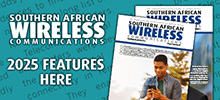29 November 2023

IoT is enabling fantastic new applications that deliver huge benefits to businesses and consumers across the globe. In support of widespread IoT rollout, wireless connectivity coverage is evolving in turn - Amy Saunders asks the experts to elaborate
The Internet of Things (IoT) is taking the world by storm. According to Statista, industrial IoT (IIoT) revenues in Africa alone are expected to expand at a compound annual growth rate of 17.5% to US$16.81 billion over 2023-2028. With such hefty revenues being generated, where and how is IoT being utilised across Africa today?
IoT in Africa
IoT is being widely utilised across Africa to support the continent’s unique opportunities and needs.
Its use has increased drastically in Africa over the last 5+ years, particularly as mobile networks become more robust and 4G and similar technologies are rolled out more widely, opines Christopher Baker-Brian, CTO and co-founder, Bboxx. “IoT is being used in remote sensor applications, in vehicle tracking and to help monitor and control pay as you go applications, from solar home systems to water pumps and other devices where remote location, tracking and switch on/off of the device based on payment status is important.”
While in some cases there are just a handful of communities acting as test cases, IoT can enable people to live their lives in closer proximity to the natural world. In agriculture, for example, sensors can be used to monitor disease within crops, temperature, water supply and soil quality, ultimately helping farmers to make informed decisions about harvest and reduce food waste.
Because modern mobile connectivity is the ‘default’ connectivity method across many African countries with good coverage, it has enabled many IoT opportunities, shares Hein Koen, director, SIMcontrol.
Transportation is one: “most goods transport in Africa is by road, due to poor rail networks. Coupled with security risks in many countries, IoT solutions are leveraged for fleet management, vehicle tracking, and logistics optimisation. Real-time data from tracking devices and sensors enable businesses to track vehicle location, monitor fuel consumption, and ensure the safety of cargo loads,” says Koen.
Continuing, Koen adds security as another key application for IoT. “Many African countries experience high crime rates. IoT security technology has seen wide adoption and many such security solutions are being developed in Africa, such as cash handling, ATM monitoring, smart alarms, cable theft sensors and other smart security solutions.”
Water scarcity is another example of a problem that IoT is helping to solve. Some 780 million people worldwide don’t have access to an improved water source according to the Centres for Disease Control and Prevention. Water systems are continuously installed but 65% break within the first two years, which adds to the mounting problem in the most remote and disadvantaged communities.
The adoption and implementation of IoT across Africa varies in different regions due to factors including infrastructure availability, technological readiness, policy, and financial resources. Nonetheless, IoT is gradually making its way across the continent – in some regions more than others.
Transforming the face of a continent
The African continent is experiencing rapid urbanisation, population growth, and increasing connectivity, creating a favourable environment for the adoption of IoT.
While it’s true that, in terms of current actual volumes, IoT in Africa is much smaller than on any other continent, the explosion of pay as you go financing and the need to manage expensive assets in remote areas of the continent mean growth rates are very exciting over the next decade, with tens of millions of devices set to be deployed, according to Baker-Brian. “We have seen year-on-year increases in our portfolio of remotely managed IoT solar home systems since we first started deploying them in 2015.”
Indeed, given the challenges faced across the continent - limited infrastructure, access to services, and resource constraints – IoT offers opportunities to improve various aspects of life and business operations.
“From improving agricultural productivity to enhancing healthcare access, IoT solutions have the potential to make a significant impact in Africa,” says Koen. “Additionally, the growth of reliable mobile connectivity where fixed infrastructure did not exist, and the increasing availability of affordable devices contribute to the rising demand for IoT solutions. Especially in the specialist security sector, many IoT solutions are being developed in Africa.”
From solar power and wind farms to smart cities fuelled by renewable resources, IoT is changing the face of Africa for the better. By providing decentralised access to energy, financial services, and healthcare, IoT provides Africans with the option of maintaining rural lifestyles without suffering as a result.
Balancing application requirements
A range of connectivity options is available to empower IoT – cellular, Low Power Wide Area Networks (LPWAN), satellite, and WiFi – however, the choice of technology varies based on the specific requirements of IoT applications, such as range, data rate, power consumption, and deployment costs.
“Due to the lack of fixed line infrastructure and associated WiFi connections, GSM, 3G, and 4G connections are the main connection types that we see growing across the African continent,” says Baker-Brian. “Over the last 5+ years, mobile coverage has improved dramatically, driven by the growth in mobile money payment systems and the widening adoption of smartphones on the continent, which has pushed operators to improve coverage rates and connection reliability, especially in more rural areas — although in some markets high speed data connections (3G+) remain a challenge. Bboxx uses 2G connectivity solutions, working with MNOs.”
Koen agrees that the most utilised connectivity technologies for IoT are either cellular: “GSM mobile networks provide wide coverage and are already established across the continent. They are used for applications that require low to high data transfer rates, such as basic sensor monitoring up to remote CCTV monitoring. Most IoT devices in Africa use 2G, 3G or 4G mobile network data connectivity,” or narrowband IoT (NB-IoT); “NB-IoT is a LPWAN technology that enables long-range communication with low power consumption. It is suitable for applications that require low data rates, long battery life, and deep indoor penetration, such as smart metering and asset tracking.”
These connectivity technologies are utilised because they offer a balance between coverage, power consumption, data rates, and cost-effectiveness, making them suitable for various IoT applications in Africa, adds Koen.

In support of IoT
IoT is changing the face of connectivity in Africa, pushing the boundaries of network optimisation, security, and data management. Indeed, with millions of IoT devices now connecting with African networks, MNOs are placing a larger importance on providing reliable services for these devices.
“Investment into network reliability is increasing, especially in larger cities, which has a knock-on impact on wireless communication provision,” says Baker-Brian.
IoT is driving the need for more robust and scalable wireless communication networks. Demand for bandwidth is set to skyrocket alongside the proliferation of IoT devices and applications across the continent. Accordingly, network optimisation has become increasingly paramount for service providers to ensure quality of service (QoS).
“IoT applications often require reliable connectivity with low latency and high network availability,” says Koen. “To meet these requirements, wireless communication providers are optimising their networks to accommodate the specific needs of IoT devices. This includes deploying small cells, enhancing coverage in remote areas, and improving network capacity to handle the increased device density.”
As we’ve seen in the latest Nokia Threat Intelligence Report, IoT botnet Distributed Denial of Service (DDoS) traffic, originating from many insecure IoT devices with the aim of disrupting telecom network services for millions of users, increased fivefold over the past year. As such, ensuring the security and privacy of IoT networks and data becomes paramount.
“Connectivity service providers offer secure managed private APN services on top of local mobile network infrastructure to ensure robust security measures including encryption, authentication protocols, and continuous monitoring for potential vulnerabilities,” says Koen.
As IoT continues to evolve, wireless communication providers will play a crucial role in enabling the seamless integration and connectivity of IoT devices, supporting the growth of connected ecosystems. These expanded, upgraded, and secured networks also provide knock-on benefits to other applications in the wireless communications sphere, and deliver new high-speed services to users in metro and rural areas, helping address the digital divide.






